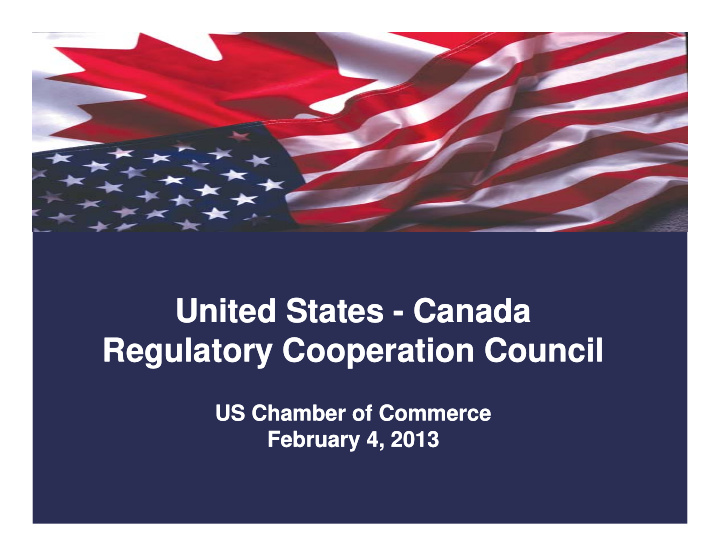



United States - Canada United States - Canada Regulatory Cooperation Council Regulatory Cooperation Council US Chamber of Commerce US Chamber of Commerce February 4, 2013 February 4, 2013 1.
Our Mandate • “The President and the Prime Minister have taken this initiative because they believe that their citizens deserve smarter, more effective approaches to regulation that enhance the economic competitiveness and well-being of the United States and Canada, while maintaining high standards of public health and safety and environmental protection.” From the Joint Statement by President Obama and Prime Minister Harper on Regulatory Cooperation that directed the creation of the RCC – February 4, 2011 2.
Recap of RCC to Date Recap of RCC to Date • RCC requests public/stakeholder input Spring 2011 • Binational working groups established Mid-2011 • Consultations summary report released August 2011 • RCC Joint Action Plan released December 2011 • Formal stakeholder meetings January 2012 • Working Group/overarching consultations Ongoing since Spring 2012 • U.S. Executive Order promoting int’l regulatory May 2012 cooperation issued by President Obama • Work plans detailing implementation Spring/Summer 2012 of 29 initiatives completed and released • First Report to Leaders December 2012 3.
Looking Back Looking Back • Importance of stakeholder role established – dialogue with departments and agencies – involvement in Work Plan development and implementation – opportunity for deeper and more frequent engagement • Appetite apparent for regular communications on progress • Issues resolution generally progressing well, and we’re beginning discussions on systemic/ongoing alignment • Lessons learned in individual Work Plans will help us develop cross-cutting principles that will lead to additional opportunities for cooperation/partnership – product reviews and approvals – standard setting – regulatory outcomes and systems reliance – managing third country import risks 4.
Current Highlights • Work Plan deliverables – Health Canada/U.S. Food and Drug Administration (FDA): aligning monograph elements for over the counter drugs – Agriculture and Agri-Food Canada (AAFC)/U.S. Department of Agriculture: agreement on animal disease zoning – Health Canada/FDA: simultaneous review and approval of veterinary drugs – Transport Canada/U.S. Coast Guard: Memorandum of Understanding – Transport Canada/U.S. Pipeline and Hazardous Materials Safety Administration (PHMSA): Memorandum of Cooperation 5.
Current Highlights (continued) • Recent stakeholder outreach – Detroit Auto Show – Nanotech Webinar – Canadian American Business Council (CABC) event • Other activities consistent with RCC goals – CPSC/Health Canada: commitment to collaborate on development of international toy safety standards in ASTM International – Environment Canada: alignment with U.S. corporate average fuel economy (CAFE) standards – NHTSA: substantial similarity determination with respect to certain vehicles that comply with Canadian Motor Vehicle Safety Standards (CMVSS) 6.
Looking Ahead Looking Ahead • Next year – key RCC objectives: 1. Sustained efforts on Work Plan implementation 2. Increased focus on ongoing mechanisms (goal is to gradually change the regulatory culture) 3. Development of a go-forward plan for U.S.-Canada regulatory cooperation: 2013 and beyond 4. Enhance level of engagement with stakeholders 7.
Looking Ahead – Looking Ahead – Adjustments and Approach Adjustments and Approach • Enhance Work Plans – adjust for opportunities to facilitate implementation – ensure simultaneous focus by Working Groups on ongoing mechanisms to enhance ability to align future regulations – learn from experience • Inform ongoing mechanisms discussion – workshop with regulators on margins of next stakeholder mtg • Discuss MOUs and other mechanisms developed thus far • What’s worked, what are the challenges/limitations • Develop standard template for such arrangements • Internal work on enablers to regulatory cooperation – to facilitate greater cooperation and alignment (e.g., information sharing, aligning regulatory processes and policies) 8.
Looking Ahead – Looking Ahead – Stakeholder Engagement Stakeholder Engagement • More structure and frequency – Exploring ideas to regularize interaction between Canadian and U.S. officials involved in RCC work and interested stakeholders (Q1 2013) • Seek to harness energy/ideas from stakeholders to help inform the process • Goal is to provide additional opportunities for updates on progress of specific Work Plans, soliciting feedback on implementation, and discussing upcoming plans • Stakeholder conference in Ottawa (spring tbd) • Expand reach through consulates 9.
What Stakeholders Can Do What Stakeholders Can Do • Engage with Working Groups and with RCC • Signal importance of RCC within both government administrations • Align priorities and efforts between Canadian and U.S. associations, companies, and standards/conformity assessment players • Assist in identifying environmental, health, safety, and economic benefits – both anecdotal examples and quantification, where possible • Ongoing discussions on forward plan at RCC Secretariat level • Formalize and post quarterly engagement schedules 10.
Additional Thoughts • Developments point to a gradual change in regulatory culture: cooperation as an emerging norm – Consistent with policy direction from President Obama and Prime Minister Harper • Creativity/adjustments will be key to continued progress • Enhanced dialogue/activities between our regulators is a really good thing – Increases chances of alignment, even in non-Work Plan areas – Enables us to spot potential issues earlier and make necessary environmental, health, and safety improvements – Will save resources over the long-term – Improves ability to influence development of global regulatory norms 11.
For More Information RCC Canadian Secretariat at rcc-ccr@pco-bcp.gc.ca Web site: www.actionplan.gc.ca/RCC or U.S. RCC at rcc@trade.gov Web site: www.trade.gov/rcc 12.
The Shared Vision – The Shared Vision – Regulatory Cooperation Council Regulatory Cooperation Council 13.
Recommend
More recommend